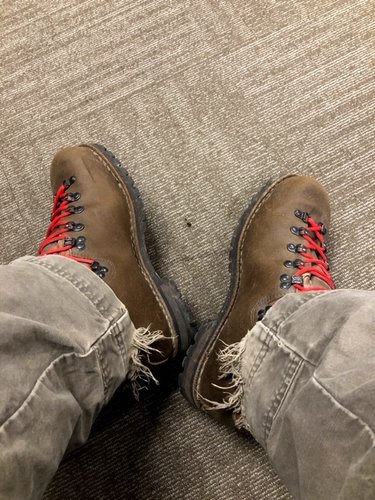Nameless Range
Well-known member
This is not a thread about boot brands, and it is true that there have been threads on HuntTalk already about breaking boots in, but I am fairly ignorant on the subject and have some questions.
A couple weeks ago, my dad purchased a pair of Alico Mountaineering Boots. It turned out they were too small for him, but he knew I was in the market for a pair of boots and gave them to me as he has slightly larger feet than me (I wear 11). I don't know much about this brand of boot, but the reviews I read online were positive, and I can tell you they are a stout and solid boot.
Anyway, I took them for a hike last Thursday. I was about 3 miles in when I began to feel the burn of blister development, specifically on the back of my heel. I turned back to the truck immediately, and by the time I had put 6 or so miles on them, just above my heel on the right foot I was raw as hell. It crippled me up for a day, and I had fire training all day Saturday. By the time I took my fire boots off Saturday evening my heel was soaked in blood.
Some statements and then questions:
-The boots fit well in terms of toe box, width, etc. On level ground they are comfortable but on inclines I get heel slippage that rubs terribly on my right foot.
-I wore double socks
-I purchased some insoles to lift my heel a bit on Sunday, and will try them for round two once the scab falls off
-These boots are Perwanger Leather, and you are not supposed to treat them with oil-based treatments.
-As they are right now(new), these boots are very stiff
-Is heel slippage a sign of a boot that has not been broken in? I have never had to break in a pair of boots and I have never dealt with blisters on any pair of boots I have tried except a pair of Kenetreks years ago. What does "breaking in" a boot mean?
-Outside of proper lacing, insoles, and double socks, are there any other recommendations to deal with heel slippage?
-Is it strange that I am only having this problem on one of my feet? I cannot identify any physical differences between the left and right boot.
-Are these just not that great of boots or is it possible they are just incompatible with my feet?
-Is heel slippage something that "breaking a pair of boots in" eventually alleviates? Is there hope for these boots?
Any advice is appreciated.

A couple weeks ago, my dad purchased a pair of Alico Mountaineering Boots. It turned out they were too small for him, but he knew I was in the market for a pair of boots and gave them to me as he has slightly larger feet than me (I wear 11). I don't know much about this brand of boot, but the reviews I read online were positive, and I can tell you they are a stout and solid boot.
Anyway, I took them for a hike last Thursday. I was about 3 miles in when I began to feel the burn of blister development, specifically on the back of my heel. I turned back to the truck immediately, and by the time I had put 6 or so miles on them, just above my heel on the right foot I was raw as hell. It crippled me up for a day, and I had fire training all day Saturday. By the time I took my fire boots off Saturday evening my heel was soaked in blood.
Some statements and then questions:
-The boots fit well in terms of toe box, width, etc. On level ground they are comfortable but on inclines I get heel slippage that rubs terribly on my right foot.
-I wore double socks
-I purchased some insoles to lift my heel a bit on Sunday, and will try them for round two once the scab falls off
-These boots are Perwanger Leather, and you are not supposed to treat them with oil-based treatments.
-As they are right now(new), these boots are very stiff
-Is heel slippage a sign of a boot that has not been broken in? I have never had to break in a pair of boots and I have never dealt with blisters on any pair of boots I have tried except a pair of Kenetreks years ago. What does "breaking in" a boot mean?
-Outside of proper lacing, insoles, and double socks, are there any other recommendations to deal with heel slippage?
-Is it strange that I am only having this problem on one of my feet? I cannot identify any physical differences between the left and right boot.
-Are these just not that great of boots or is it possible they are just incompatible with my feet?
-Is heel slippage something that "breaking a pair of boots in" eventually alleviates? Is there hope for these boots?
Any advice is appreciated.

Last edited:




